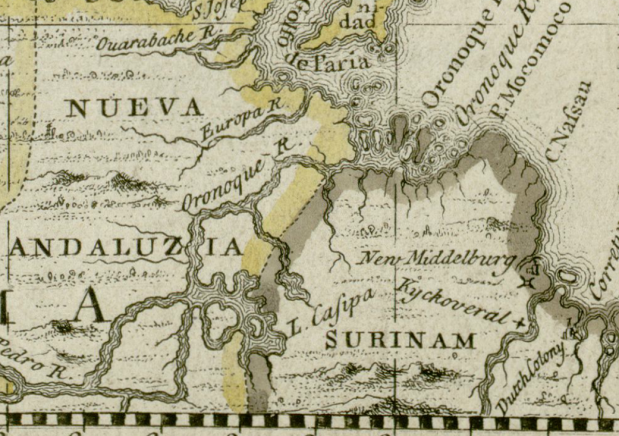In 1494 the only complete genocide of a people, the Taino, commenced with the arrival of Christopher Columbus, who was led to the island of Xamayca (now Jamaica) by the Arawak people of Cuba. The Arawak had convinced the bumbling explorer—who still thought he was in Asia—that there would be gold and diamonds waiting for them on Xamayca; they lied to rid themselves of this murderous band. Columbus and his men used the gentle Taino to supply his men with food—island staples such as cassava, fish, and maize—until they resisted, at which point they were enslaved, raped, tortured, murdered, mutilated, and starved, crippling their ability to farm such important foods as the Scotch bonnet pepper. The Taino genocide (1492–1518) wiped out the inhabitants of the Greater Antilles, but Jamaica inherited some of their culture, especially foods that arrived with the Taino.
The Scotch bonnet earned its colonial name for its likeness to a tam-o’-shanter, but the tasty and fiery pepper can trace its roots to the lowland jungles of the western Amazon basin in what is now called Brazil. The designation of the hot pepper derives from another mistake by Columbus, who thought that chilies were the hot peppercorns found in Asia. Scotch bonnets are as hot as habaneros but have a sweeter profile, making them ideal as a base for Jamaican dishes like jerk barbecue, ackee and saltfish, pepper pot soup, and curries.

The original explorers of the Antilles, the Taino and later the Caribs, transported Scotch bonnets and other staples such as cassava as well as animals on huge canoes that could hold between 50 and 70 people at a time. Both of these Arawakan subgroups originated in the Orinoco River Valley in what is present-day Venezuela. The Taino from the Yucatán Peninsula and Belize were pioneers in traveling to Cuba, and they took a variety of chilies with them. Jamaica’s spicy culinary symbol belongs to a breed of chilies known as Capsicum chinense, a less popular species than Capsicum annuum yet belonging to the most punishing and caustic genus of chilies known to man. This includes the Carolina Reaper; Bhut jolokia, or ghost pepper; the Trinidad scorpion; and the habanero, pride of the Yucatecan kitchen and where Mexicans choose to tap out. ¡No más!
Current evidence dates the cultivation of Capsicum annuum in Mexico and Central America to around 7500 B.C., but wild peppers spread from South America throughout the Americas by way of bird droppings until Arawak-speaking peoples introduced them to the Caribbean islands. The Arawak arrived in two waves: The first took place around A.D. 650; the second occurred in 850 and 900, moving up the Antilles and subjugating the Ciboney on islands like Cuba. The people from the Orinoco River Valley brought chili peppers and barabicu, the Arawakan word for what you might expect: pit cooking over an open fire.
The Columbian exchange introduced the five domesticated species of capsicum to Europe, Africa, and Asia, where more varieties developed, crisscrossing the globe to the point where many consumers in Asia and Africa are unaware that chili peppers originated in the Americas. Local preferences, hybridization, and culinary uses determined the types of chili peppers that would become part of the cuisine: roasted shishito peppers in Japan, paprika in Morocco and Hungary, Tien Tsin in Hunan, China. But the Taino selected the incendiary Scotch bonnet to leave a lasting, pungent sting on the tongues of all Jamaicans.
The Taino thrived until the arrival of Columbus in 1494, threatened only by the fierce Caribs, who dominated the Lesser Antilles and struck fear into Taino hearts. By 1518 the forced labor, killings, and smallpox imported by the explorers had destroyed the Taino of the Greater Antilles. Eventually they enslaved and transported Africans to replace the loss of Xamayca’s labor force. Little is known about this tragic period outside the observations of Bartolomé de las Casas and a few others who sympathized with the plight of the Amerindian peoples. On May 10, 1655, it all came to an end; Jamaica was a failed Spanish colony, clearing a path for the British, who were able to force the Spaniards to surrender. As the Spaniards retreated from Jamaica, they freed their slaves, who became known as maroons.
The foods and a few culinary traditions of the original explorers from the Orinoco River Valley to Xamayca, like jerk, was inherited by the maroons, who had banded together in the mountains, resisting their British oppressors along with the last Taino and likely intermarried. Using Taino practices, the maroons became barbecue-pit masters; and the Scotch bonnet’s exceptional versatility in flavor and heat became the soul of the island’s cuisine, which incorporates West African traditions from the maroons.
Others have contributed to this potluck of occupations and migrations from the Spanish, British, East Indian, Portuguese, Chinese, French, and Dutch. Still, in brilliant lacquered shades of pumpkin, yellow, firetruck red, and green, the Scotch bonnet shines brightest. Each tear-inducing bite reverberates with the odyssey of the earliest human migrations, genocides, and struggles to survive the colonization of the Americas, and the birth of modern Jamaica.